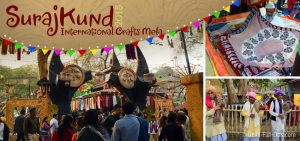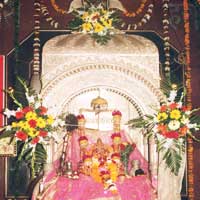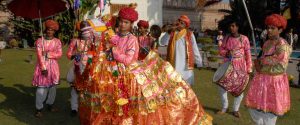Fairs and festivals of Haryana
The state of Haryana celebrates the rich, glorious culture of India in its various fairs and festivals that are celebrated with equal pomp and gaiety here as all over the country. There are several fairs and festivals in Haryana that attract a large number of visitors to the state at different times of the year. These festivals are occasions of celebration, fun and frolic when the entire state of Haryana bustles with life.
FAIRS
Surajkund International Fair
Each year during the month of February, the department of Haryana Tourism organizes a cultural fest, which is popularly known as Surjakund Fair. It is celebrated no less than any big festival in Haryana and the sole motive behind organizing this fair is to promote the traditional art and talent that exist in our country. People from different cities and countries come here to mark their presence and witness the richness of traditional Indian crafts present in this grand fest. Beautifully deco
Pinjore Heritage Festival
Pinjore in Haryana plays host to the Pinjore Heritage Festival, a yearly fair that offers one a chance to get a sneak-peak into the rich heritage, gardens of Pinjore as well as its promotion in the form of a potential tourist destination. Pinjore is an ancient town that finds its roots way back in Vedic times and has various tourist attractions in abundance, its gardens being the prime one. This annual event is managed by the Haryana Tourism Department and other chief state bodies. The celebrations of the Pinjore Festival started in 2006. Each year, Yadavindra Garden, which is famed as one of the oldest as well as the most well maintained Mughal gardens around the globe is the festival’ s venue. The garden has an interesting 7-descending level of arrangement and after being established by the Mughal rulers, it has been taken care of by the rulers of Himachal Pradesh, the royal house of Patiala and the Gorkhas and now by the Haryana Tourism Department.
The Pinjore Heritage Festival is mainly an exhibition of the culture and tradition of the north Indian state of Haryana. A cultural concoction, this affair is attended by artists from all over the country who showcase their art and contribute towards the success of the event.
Gopal-Mochan Fair
In Ambala, the most famous fair is held at Gopal-Mochan near Bilaspur in Jagadhari tehsil. There is a sacred tank of the same name in the place. The legend is that once Lord Shiva while rescuing Saraswati, who was being pursued by Brahma, struck off the latter’s head. A lock of hair was left in Shiva’s hand and his body was blackened. For a long time Shiva was unable to cleanse himself. One night, when he was resting at a cow shed he overheard the conversation between a cow and her calf. The calf said he was going to kill his master, a Brahmin, to avoid being castrated. The cow tried to dissuade the calf from the sin, but the calf said, it knew of a tank where it could cleanse itself from the sin of killing a Brahmin. Shiva followed the calf the next day and saw it kill its master. The bodies of the cow and the calf where then blackened until they cleansed themselves by bathing in Gopal Mochan tank. Shiva followed their example and was like wise cleansed. Since then the water of Gopal-Mochan have retained their virtue. It is considered by many to be more efficacious than the waters of the Ganges at Hardwar. The Rin Mochan is another water tank situated close to the Gopal-Mochan. A big fair is held in the village in the month of Kartik.
Masani Fair
Haryana’s most famous fair is held in honor of the goddess of small-pox, Masani whose temple is in Gurgaon village. There is a legend about this temple. There was a shrine, sacred to the goddess Devi, locally known as Masani at the village of Kesopur in the Delhi district. Some two hundred and fifty years ago according to tradition, the Goddess appeared in a dream to one Singha, a Jat of some influence and a resident at the village of Gurgaon. The Devi communicated to Singha that she wished to leave Kesopur and directed him to construct a shrine for her in his village. At the same time, she authorized the 
FESTIVALS
Diwali
In Haryana Diwali is celebrated with great enthusiasm. It comes in the middle of the month of Karthik. First comes the little Diwali on which rice and sugar put in vessels, with a paisa placed on the top, are given away to Brahmins and girls. The deceased ancestors are said to visit the house of their families on that day, and it is in their name that the ceremony is performed. Houses are whitewashed and cleaned. On the next day, or Govardhan, Diwali lamps are lighted in the evening and sweets distributed. On the following day all the sweepings are thrown out on to the refused dumps outside the village. The old lamps are also thrown their and new ones placed in the house. The rich and trading classes specially consider Diwali as their own festival. On this occasion they perform pujas, which are considered auspicious for their profession. Diwali is also celebrated by gambling in various ways throughout the night accompanied by merry making. For children Diwali provides an occasion for fire works.
Gugga Naumi
This is a religious festival, celebrated all over Haryana. It is connected with snake-worsh
Bathing at Sohna
Sohna is famous for its hot springs, which have medicinal qualities, several thousand people assemble at Sohna on Somwati Amawas to bathe in sulphur springs. The crowd would be small if the festival happens to fall during harvest-time.
Holi
Holi is celebrated with considerable zest, particularly in the area bordering Uttar Pradesh. Four days before the festival, married women play Holi with their men folk by throwing colored water on them. The day following Holi, Dhulandi (Phag), men folk throw water on women who retaliate by a mock beating with sticks or kolras (twisted cloth strips). The men act as if they are powerless and they pretended attempts at shielding themselves lead to much fun and amusement.
Dussera
Dussera is probably the chief Hindu festival, being associated with the great Epic Ramayana and its renowned hero, Rama. The celebrations last nearly a month. First come the Shradas, early in September and lasts over a fortnight. The Brahmins are fed on these days in memory of the deceased elders of the family. The Shradas are followed by Nauratas, which as the name implies are nine in number. Oats sown in the field or deposited in big utensils, are watered on each of these days. On the Dussera day, pudding (halwa) is eaten with rice and cured. The Brahmins are also fed. All the members of the family except woman put stalks of green oats on their head. Ram Leela is enacted in various places. On the last day the effigies of the demon king Ravana and his supporters are burned, which forms the concluding event. More about Dussera,
Haryana is a state in northern India. It is bordered by Punjab to the north, Himachal Pradesh to the east, Uttarakhand to the southeast, Uttar Pradesh to the south, Rajasthan to the southwest, and Delhi to the west. The state has a Population of over 28 million people and is the 10th most populous state in India. The capital of Haryana is Chandigarh, which is also the joint capital of Punjab.
Haryana is a land of rich culture and heritage. The state is home to a number of fairs and festivals that are celebrated throughout the year. These fairs and festivals are a way for people to come together and celebrate their culture and traditions. They are also a time for people to socialize and enjoy themselves.
Some of the most popular fairs and festivals in Haryana include:
- Baishakhi is a major harvest festival that is celebrated in the month of April. It is a time for people to give thanks for the good harvest and to pray for a prosperous year ahead. The festival is celebrated with great pomp and show, with people dancing, singing, and feasting.
- Baisakhi Mela is a fair that is held in the city of Kurukshetra every year. The fair is a major tourist attraction and is known for its cultural performances, traditional food, and shopping.
- Bhadra Deepawali is a Hindu festival that is celebrated in the month of October. It is a time for people to pray to Lakshmi, the goddess of wealth and prosperity. The festival is celebrated with great pomp and show, with people lighting diyas (lamps), exchanging gifts, and feasting.
- Chhoti Holi is a Hindu festival that is celebrated in the month of February. It is a time for people to play with colors and to celebrate the arrival of spring. The festival is celebrated with great joy and enthusiasm, with people dancing, singing, and playing with colors.
- Durga puja is a Hindu festival that is celebrated in the month of October. It is a time for people to worship Durga, the goddess of power and protection. The festival is celebrated with great pomp and show, with people setting up pandals (temporary shrines), offering prayers, and feasting.
- Ganesh Chaturthi is a Hindu festival that is celebrated in the month of August. It is a time for people to worship Ganesha, the god of wisdom and prosperity. The festival is celebrated with great pomp and show, with people setting up pandals, offering prayers, and feasting.
- Hola Mohalla is a Sikh festival that is celebrated in the month of March. It is a time for people to celebrate the victory of good over evil. The festival is celebrated with great enthusiasm, with people participating in mock battles, horse races, and other sporting events.
- Janmashtami is a Hindu festival that is celebrated in the month of August. It is a time for people to celebrate the birth of Krishna, the eighth avatar of Vishnu. The festival is celebrated with great pomp and show, with people setting up pandals, offering prayers, and feasting.
- Lohri is a Punjabi festival that is celebrated in the month of January. It is a time for people to celebrate the arrival of spring and to pray for a good harvest. The festival is celebrated with great joy and enthusiasm, with people dancing, singing, and feasting.
- Maha Shivratri is a Hindu festival that is celebrated in the month of February. It is a time for people to worship Shiva, the god of destruction and regeneration. The festival is celebrated with great pomp and show, with people setting up pandals, offering prayers, and feasting.
- Makar Sankranti is a Hindu festival that is celebrated in the month of January. It is a time for people to celebrate the harvest and to pray for a good year ahead. The festival is celebrated with great pomp and show, with people flying kites, eating tilgul (a sweet made of sesame seeds and jaggery), and feasting.
- Navratri is a Hindu festival that is celebrated in the month of October. It is a time for people to worship Durga, the goddess of power and protection. The festival is celebrated with great pomp and show, with people setting up pandals, offering prayers, and feasting.
- Raksha Bandhan is a Hindu festival that is celebrated in the month of August. It is a time for sisters to tie a rakhi (a sacred thread) on their brother’s wrist and to pray for their well-being. The festival is celebrated with great joy and enthusiasm, with people feasting and exchanging gifts.
- Teej is a Hindu festival that is celebrated in the month of July. It is a time for women to celebrate their marital bliss and to pray for the well-being of their husbands. The
What are the most popular fairs and festivals in Haryana?
The most popular fairs and festivals in Haryana are:
- Raksha Bandhan is a Hindu festival celebrated on the full moon of the month of Shravana (AugustâSeptember). It is a day when sisters tie a sacred thread (rakhi) on their brother’s wrists as a symbol of love and protection.
- Lohri is a Punjabi harvest festival celebrated on the 13th of January. It is a time to celebrate the arrival of spring and the harvest season. People gather around bonfires, sing songs, and dance.
- Holi is a Hindu festival of colors celebrated on the full moon of the month of Phalguna (FebruaryâMarch). It is a time to celebrate the victory of good over evil and to forget and forgive all grudges. People throw colored powder and water at each other and dance in the streets.
- Diwali is a Hindu festival of lights celebrated on the 15th of the month of Kartik (NovemberâDecember). It is a time to celebrate the victory of good over evil and to welcome the new year. People decorate their homes with lights and diyas (lamps), exchange gifts, and feast on delicious food.
- Guru Nanak Dev Ji’s birthday is a Sikh festival celebrated on the 15th of the month of Vaisakh (AprilâMay). It is a time to celebrate the birth of Guru Nanak Dev Ji, the first Guru of Sikhism. People gather in gurdwaras (Sikh temples) to listen to kirtan (devotional music) and to offer prayers.
- Maha Shivratri is a Hindu festival dedicated to the god Shiva. It is celebrated on the 14th night of the month of Phalguna (FebruaryâMarch). It is a time to fast, meditate, and worship Shiva.
- Janmashtami is a Hindu festival celebrating the birth of Krishna, the eighth avatar of Vishnu. It is celebrated on the 8th day of the dark half of the month of Bhadrapada (AugustâSeptember). It is a time to fast, pray, and sing songs in praise of Krishna.
- Eid-ul-Fitr is a Muslim festival that marks the end of Ramadan, the holy month of fasting. It is celebrated on the first day of the month of Shawwal (JuneâJuly). It is a time to feast, celebrate, and give gifts.
- Christmas is a Christian festival that celebrates the birth of Jesus Christ. It is celebrated on the 25th of December. It is a time to spend with family and friends, exchange gifts, and feast on delicious food.
What are some of the unique traditions and customs associated with these fairs and festivals?
Each of the fairs and festivals mentioned above has its own unique traditions and customs. For example, on Raksha Bandhan, sisters tie a sacred thread (rakhi) on their brother’s wrists as a symbol of love and protection. On Lohri, people gather around bonfires, sing songs, and dance. On Holi, people throw colored powder and water at each other and dance in the streets. On Diwali, people decorate their homes with lights and diyas (lamps), exchange gifts, and feast on delicious food. On Guru Nanak Dev Ji’s birthday, people gather in gurdwaras (Sikh temples) to listen to kirtan (devotional music) and to offer prayers. On Maha Shivratri, people fast, meditate, and worship Shiva. On Janmashtami, people fast, pray, and sing songs in praise of Krishna. On Eid-ul-Fitr, people feast, celebrate, and give gifts. On Christmas, people spend with family and friends, exchange gifts, and feast on delicious food.
What are some of the benefits of celebrating these fairs and festivals?
There are many benefits to celebrating fairs and festivals. They provide a time for people to come together and celebrate their culture and traditions. They also provide a time for people to socialize and make new friends. Additionally, fairs and festivals can be a great source of entertainment and fun.
Sure. Here are some MCQs about Haryana:
Which of the following is not a city in Haryana?
(A) Gurgaon
(B) Faridabad
(C) Noida
(D) RohtakWhich of the following is the capital of Haryana?
(A) Chandigarh
(B) Panchkula
(C) Karnal
(D) KurukshetraWhich of the following is the main language spoken in Haryana?
(A) Hindi
(B) Punjabi
(C) Haryanvi
(D) EnglishWhich of the following is the main religion in Haryana?
(A) Hinduism-2/”>Hinduism
(B) Islam
(C) Sikhism
(D) ChristianityWhich of the following is the main crop grown in Haryana?
(A) Wheat
(B) Rice
(C) Cotton
(D) SugarcaneWhich of the following is the main river that flows through Haryana?
(A) Yamuna
(B) Ganges
(C) Indus
(D) BrahmaputraWhich of the following is the main tourist attraction in Haryana?
(A) Kurukshetra War Memorial
(B) Surajkund Mela
(C) Pinjore Gardens
(D) all of the aboveWhich of the following is the main export of Haryana?
(A) Machinery
(B) Textiles
(C) Automobiles
(D) ElectronicsWhich of the following is the main import of Haryana?
(A) Crude oil
(B) Coal
(C) Iron Ore
(D) FertilizersWhich of the following is the main Industry in Haryana?
(A) agriculture
(B) Manufacturing
(C) Services
(D) all of the above
I hope these MCQs were helpful!
